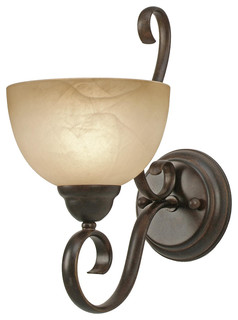Thanks to Houzz.com, we have the basic Frequently Asked Questions about those lights in the middle of the wall:
Why might you consider a wall sconce? Wall sconces are a great way to add lighting without taking up precious floor space, making them ideal for narrow spaces, such as hallways. They can provide ambient or task lighting, and can work as the main light source or simply as a complement to existing lamps. With lots of styles to choose from, a wall sconce can also add an extra punch of decoration.
What types of styles are available? Options are endless when it comes to wall sconces, making it easy to match the style and look you desire. Determine what’s right for you by first evaluating the size of the room you’re working in. Then figure out if it will act as a primary or complementary source of lighting to the existing room décor. An oversized cast iron fixture will provide ample, ambient lighting while lending a rustic look to your space. For a modernized look, place slender wall torchieres with clean, straight lines on either side of your fireplace.
Where in the home should you place your wall sconce? Any room in the home can benefit from a wall sconce, but determine exactly what you want from your lighting to decide where one will work best for you. Sconces are great for flanking paintings, bathroom mirrors, and headboards, as well as adding light to a reading nook without a table. They’re also helpful in small entryways, hallways or staircases where floor space is minimal.
Where on the wall should you place the wall sconce? This depends on the size of the room, but in general, they should be mounted 60-66” above the ground. Spread them anywhere from 6 to 10 feet apart: closer to 6 feet if you want more fixtures and thus more light, or closer to 10 feet if you prefer less light. If you’re lining a staircase with sconces, avoid seeing the bulb from above the fixture by adding a closed diffuser onto the sconce or by using a downlight.
What should you consider in terms of installation? Take into account whether your wall has been pre-wired to accept a wall sconce. If it hasn’t, you may need to hire a professional to help you install it. If you don’t want to deal with the extra expense and effort, seek out a sconce that simply require a cord and plug application.

No comments:
Post a Comment